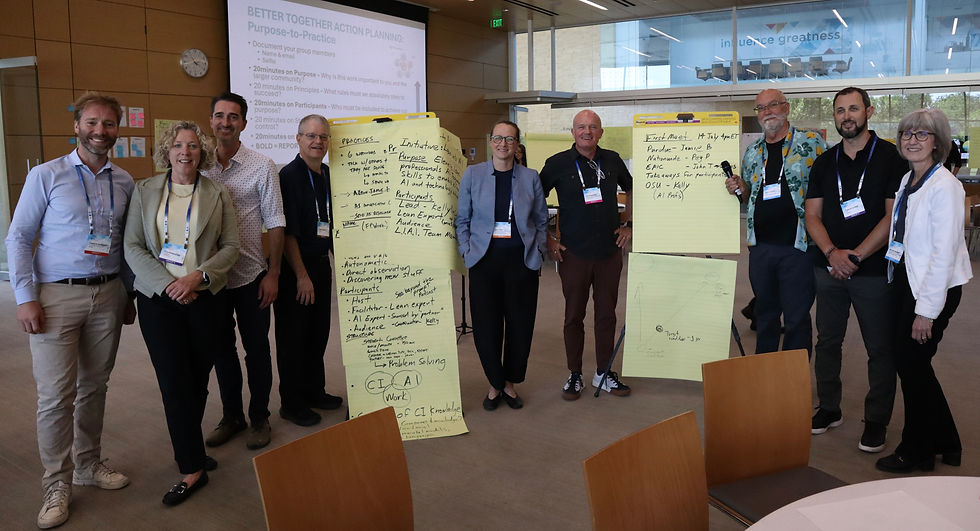Building Problem-Solving Cultures: Insights from the OSU COE Summit
- FPW Team

- Apr 22
- 4 min read

In today's rapidly evolving workplace, organizations face a critical challenge: how to create cultures where improvement is everyone's responsibility, not just a specialized function. At the recent Ohio State University Center for Operational Excellence Summit, we had the opportunity to facilitate an interactive session exploring this challenge with improvement leaders from diverse industries.
What emerged was a fascinating consensus around core barriers to building problem-solving cultures—and practical approaches to overcoming them. The insights revealed a fundamental tension between the desire for quick results and the patient work of cultural transformation.
Why This Matters Across Improvement Approaches
Whether your organization practices Lean, Six Sigma, Agile, or other improvement methodologies, the challenge remains the same: sustainable improvement ultimately depends on creating cultures where every person contributes to organizational excellence. The barriers identified at our session transcend specific methodologies and reveal fundamental human and organizational challenges that affect all improvement efforts.
These challenges are particularly relevant as organizations navigate hybrid work environments, rapidly changing market conditions, and the integration of new technologies like AI. As improvement practitioners, we need frameworks that can adapt to these changing conditions while maintaining the core principles that drive lasting success.
The Problem-Solving Culture Paradox
Our session used a "What? So What? Now What?" framework to explore challenges in creating people-centered improvement cultures. Three themes emerged consistently across all discussion groups:
1. The Quick Fix Trap
Participants consistently identified the tendency to jump to idealized solutions without properly understanding current processes—favoring "quick fixes" over sustainable improvements. As one post-it note captured: "Jumping to quick fix and 'easy' instead of 'best'" leads directly to "rework" and "technical debt."
This pattern creates a vicious cycle. Quick fixes appear to solve problems but often address symptoms rather than causes. The resulting "solutions" create new problems that require additional fixes, consuming resources that could otherwise be invested in more foundational improvements.
2. The Time Investment Challenge
All three discussion groups emphasized the critical importance of dedicated time for improvement work. One particularly insightful note captured it perfectly: "Companies dedicating time and space to create culture work during work."
The significance is clear: without protected time for improvement activities, daily operational demands will consistently take precedence. Yet many organizations struggle with this fundamental requirement, viewing improvement time as a luxury rather than a necessity.
As improvement practitioners, we need to reframe this narrative. Time for improvement isn't an additional cost—it's an investment with substantial returns in quality, efficiency, employee engagement, and innovation capacity.
3. Leadership Engagement Dilemmas
Perhaps the most nuanced discussion centered around leadership's role in improvement cultures. Participants questioned whether top-down directives are effective and why lean leadership initiatives often fail.
One provocative note asked: "Why does lean leadership fail?"
What emerged was a recognition that leadership commitment must extend beyond words to concrete actions—particularly in how leaders allocate time, resources, and attention. Early investment in leadership development creates dividends later, but many organizations struggle with the patience required.
From Insight to Action
The most valuable part of our session came in the "Now What?" discussion, where participants identified practical approaches to address these challenges:
1. Make Improvement Part of Scheduled Work
Rather than treating improvement as an add-on activity, participants suggested making it part of scheduled work—setting aside specific time every day or week for addressing problems. This approach needs to include all levels, with particular emphasis on management participation to demonstrate commitment.
One specific suggestion was to dedicate a consistent block of time (e.g., 45 minutes weekly) where team members at all levels work simultaneously on problems that matter to them, creating a visible organization-wide commitment to improvement.
2. Balance Structure with Flexibility
Participants recognized the need for lightweight "intake frameworks" that provide sufficient structure for improvement initiatives without becoming bureaucratically heavy. When processes become too administratively complex, people work around them, defeating their purpose.
The ideal approach balances structure with flexibility, incorporating cross-functional "influence templates" to ensure solutions consider enterprise-wide impacts. This addresses the common problem of siloed improvements that solve problems in one area while creating new issues elsewhere.
3. Show What Good Looks Like
Multiple suggestions centered around the power of demonstration—through case studies, examples, and opportunities to "go and see what good looks like." This approach builds shared understanding of effective practices and creates motivation by making improvement benefits tangible.
Early demonstrations of value help build the commitment needed for more substantial transformation efforts. As one note suggested, organizations should develop "case studies showing long-term sustainability" with "detailed yet short messaging on WHY!"
Building Better Together
What made this session particularly valuable was the collaborative spirit—participants freely shared challenges and insights across organizational boundaries, recognizing that we face common human and organizational barriers to improvement.
This collaborative approach mirrors the core mission of the Future of People at Work (FPW) initiative, which brings together seven leading improvement organizations to explore how we can create workplaces where people and performance naturally improve together.
The challenges identified in our session aren't new, but they remain stubbornly persistent. By working together across organizational and methodological boundaries, we have an opportunity to develop new approaches that address these fundamental barriers to improvement cultures.
Join us at the Future of People at Work (FPW) Symposium, June 26-27, 2025, at OC Tanner's facility in Salt Lake City, where we'll explore these and other innovative approaches to improvement methods. Learn more at https://www.fpwork.org/
Connect with us:
Follow the FPW LinkedIn page: https://www.linkedin.com/company/future-people-work/
Register for monthly FPW conversations: https://forms.gle/yXPbCXURdfvYtjmn9
Check out this FPW related event from our partner organizations: https://www.fpwork.org/fpw-events




Comments